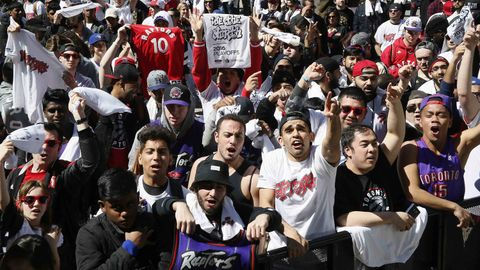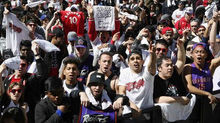The Toronto Raptors and Their Relationship with Immigration in Canada
- Ben Okazawa
- Oct 27, 2018
- 4 min read

(h/t: theglobeandmail.com)
As the NBA's only existing franchise in Canada, the Toronto Raptors have a huge effect on Canada's new immigrants coming from all over the world.
With Canada itself being a very immigration-friendly country, the largest cities within Canada (Toronto, Montreal, Vancouver) are some of the most multicultural cities in the world. Immigrants, children of immigrants, and grand-children of immigrants all contribute to the diversity of Canada.
Ever since the birth of the nation, Canada has been primarily a hockey country. Kids would go out on the skating rink in the long, cold winters, with their skates and sticks, and later would go back inside to the warmth of their houses. As they got older, many of these same kids would go on to play competitively in one league or another.
Eventually, a big wave of immigration occurred in the early 2000s, when, (per statcan.gc.ca) the percentage of visible minorities in Canada rose from just 11.2% in 1996, to 16.2% in 2006.
These were people immigrating from all over the world, mainly third-world countries, to provide a better life for their children and all the generations to come after them.
With that being said, the children of these immigrant families could not all necessarily afford to play hockey. With all the equipment that comes with playing hockey, it isn't exactly the most accessible sport for lower-income families.
That's where the Toronto Raptors come in; kids all over the country were watching Vince Carter and Tracy McGrady throw down all of those now-vintage dunks in All-Star games, Dunk Contests, regular-season and playoff games, and were just fascinated.
The kids who were excluded from hockey took the much more affordable sport of basketball, and made it their own. Whether they were simply fans with no hoop dreams, or players with all the hoop dreams in the world, these kids were given the opportunity to, in basketball, love a sport in the same way that the generations before them loved hockey.
The Raptors' Effect on the Current Generation of Immigrant Players
Anthony Bennett is maybe one of the best examples of how the Raptors affected an immigrant family in Canada. Bennett's mother immigrated to Canada from Jamaica, and worked tirelessly to provide for her three children. Growing up in the infamous Jane and Finch area of Toronto, Bennett played basketball starting at a young age, and hasn't stopped since.
As the first ever Canadian to be picked first overall in an NBA draft, Anthony Bennett had sky-high expectations for his career. Now, while his NBA career most definitely did not go where he wanted it to (he currently plays for the Maine Red Claws of the NBA G-League), Bennett still proudly represents Canada as a player on the national team.
Chris Boucher, Toronto Raptors' forward, has a similar story of his own. He moved to Montreal from Saint Lucia when he was five years old, where he lived with his mother in the northern section of the city.
While Boucher played some hockey growing up, it eventually proved too expensive to pursue. He started playing basketball for an AAU (Amateur Athletic Union) club located in the province of Quebec, called Alma Academy, when he was 16, at which point he had already dropped out of high school.
Boucher's size, natural athleticism, and love for the game all translated to a career in basketball, which funnily enough led to him playing for the team that he grew up watching, the Toronto Raptors.
There are countless stories that I could share in order to highlight just how much the Toronto Raptors have had a positive effect on Canadian immigrants-turned-players; those above are just two of many.
The Raptors' Effect on the Current Generation of Immigrant Fans
The manner in which the Raptors most clearly show how they bring the entire country together is the square in front of the Scotiabank Arena, better known as Jurassic Park.
Jurassic Park is a place where all the fans who couldn't score tickets to sit inside and watch the game can watch the game together outside, on the big screen.
Let me tell you: Jurassic Park is home to easily one of the largest, most diverse, most dedicated fan bases in the NBA right now. The Raptors have fans come from all over Canada to watch them, many of those fans being of immigrant families.
Take it back further, and pretty much anywhere in Canada during Vince Carter's time with the Raptors, (late-90s to early-2000s) you could see kids from as young as four or five, to young adults in their mid-20s, all trying to imitate any one of Carter's famous dunks from the 2000 NBA All-Star Weekend Dunk Contest.
Honestly, even now, don't be surprised if you see people from the aforementioned age range doing the exact same thing, whether it be on portable nets in the suburbs, or basketball parks in the inner-city.
The current generation of fans grew up on the likes of anyone from Vince and T-Mac to Chris Bosh and Jose Calderon to Kyle Lowry and DeMar DeRozan, depending on how old they are and when they started watching basketball.
Regardless of which mini-era of the Toronto Raptors that someone may have grown up watching, it's likely that the team had the biggest influence on fans, and the individual players less so.
Don't get me wrong; guys like Vince Carter, Chris Bosh, and DeMar DeRozan all had huge impacts on young basketball fans in Canada.
However, I believe that the individual players had more of an impact on the kids with serious NBA aspirations. Those fans would latch on to any one of the big-name Raptors at the time, and model their game after them.
It was the team that most affected the fans who just liked watching the game and playing for fun. The unity and friendships borne of a shared love for Canada's team played a big part in integrating young immigrants to the Canadian culture, while at the same time maintaining their own respective heritages.


















Comments